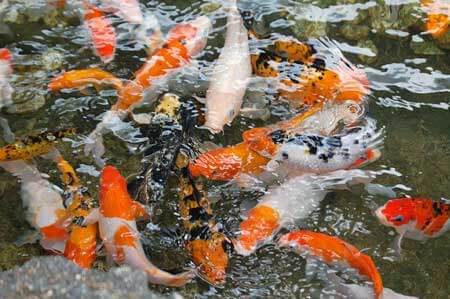“How many Koi can I stock my pond with?” A question pond experts frequently get asked. A general rule of thumb as stated by the Ornamental Aquatic Trade Association is 2kg fish per 1000 litres (or 1 inch of Koi per 10 gallons). But, in reality the answer is not as straight forward as that. There are many variables that need to be considered when stocking a pond.
Size of filtration system, water flow rate, inclusion of aquatic plants and volume of water (1500 – 2000 gallons is considered an ideal size for Koi) all impact how many fish a pond can accommodate. Investing in a high quality pond liner, pond pump and filter is a great start to investing in the perfect environment for homing Koi.
Pond size and depth of Koi pond
Another consideration is do you decide how many Koi fish you want and then build the size pond to create a healthy ecosystem to accommodate them all. Or, build first and then slowly stock your pond monitoring the water as you go? Both options are viable. You also want to consider the full grown size of the Koi. You wouldn’t want to get rid of any prize pets when, after a period of time you realize your fish are getting stressed because they don’t have sufficient space to move about in. Stress affects their immune system so best avoided.
How to determine stocking density
Known fact: fish excrete waste and consume dissolved oxygen. So, for a pond to stay healthy a good quality filtration system needs to be installed. The filter will provide beneficial bacteria that converters fish waste, uneaten fish food and decomposed matter. If waste is not dealt with it turns to ammonia.
A high quality filter, correct size pond pump and a bottom drain are essential to maintaining a healthy ecosystem for Koi to thrive. A bottom drain sucks water out of the pond and passes it through the filter. The cleaned water is pumped back into the pond. Who wouldn’t say ‘yes’ to this self-cleaning pond set-up? Another effective cleaning system is a skimmer. Both reduce the risk of sludge build-up at the bottom of a pond.
Why average water temperature is an important consideration
Koi are poikilothermic which means that their body temperature is determined by surrounding water temperature. If the water is warm, their metabolic rate increases so they consume more food, excrete more waste and require more oxygen. The opposite happens when the water temperature drops (autumn and winter months). So what impact does average water temperature have when stocking a pond? It means that in colder climates the stocking density is higher than in warm climates. Why, because less waste for bacteria to have to ‘clean-up’ and less demand on dissolved oxygen levels.

When stocking a pond the more patient you are the greater the chance of maintaining a healthy pond environment.
Should you add aquatic plants to your pond?
Koi keepers are not all in favour of adding aquatic plants to their formal ponds. Floating aquatic plants such as water lilies can reach a size that covers half the surface area. This gives fish a place to hide rather than being in full visibility. However, they do offer shade and shelter. Aquatic plants absorb nitrates from the water and release oxygen. If aquatic plants aren’t included a skimmer, aerator and large enough filter system are vital.
Conclusion
There is lots to consider when planning a Koi pond build and stocking while maintaining a healthy ecosystem for your fish to thrive in.
Important points to note are that the ideal pond size for Koi is one no bigger than a 1500 to 2000 gallon capacity and between 1. 5 to 2 meters deep. All 1500+ gallons of water will need to go through good quality filter system every three hours to maintain the health of the pond. Vertical sides and a convex bottom are preferred to allow sludge and decomposed matter to readily flow into the bottom drain to pass through the filter system.
Koi need space to move about in. Too many in a confined space will cause stress which in turn will have a negative impact on their immune system.
We hope you have found this article helpful!





